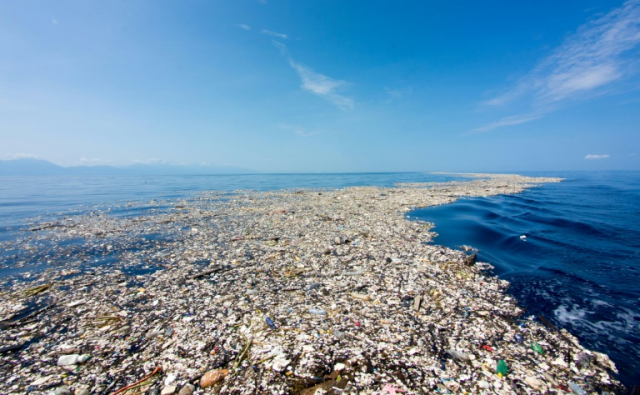
Eight million tons of plastics enter the oceans every year, much of which has accumulated in five giant garbage patches around the planet, according to a new study. Image: AFP/Caroline Power
The vast dump of plastic waste swirling in the Pacific ocean is now bigger than France, Germany and Spain combined — far larger than previously feared — and is growing rapidly, a study published Thursday warned.
Researchers based in the Netherlands used a fleet of boats and aircraft to scan the immense accumulation of bottles, containers, fishing nets and microparticles known as the “Great Pacific Garbage Patch” (GPGP) and found an astonishing build-up of plastic waste.
“We found about 80,000 tons of buoyant plastic currently in the GPGP,” Laurent Lebreton, lead author of the study published in the journal Scientific Reports, told AFP.
That’s around the weight of 500 jumbo jets, and up to sixteen times greater than the plastic mass uncovered there in previous studies.
But what really shocked the team was the amount of plastic pieces that have built up on the marine gyre between Hawaii and California in recent years.
They found that the dump now contains around 1.8 trillion pieces of plastic, posing a dual threat to marine life.
Microplastics, tiny fragments of plastic smaller than 50mm in size that make up the vast majority of items in the GPGP, can enter the food chain when swallowed by fish.
The pollutants they contain become more concentrated as they work their way up through the food web, all the way to top level predators such as sharks, seals and polar bears.
“The other environmental impact comes from the larger debris, especially the fishing nets,” said Lebreton.
These net fragments kill marine life by trapping fish and animals such as turtles in a process known as “ghost fishing”.
The research team from the Ocean Cleanup Foundation, a Dutch start-up aiming to scoop up half the debris in the GPGP within five years, were surprised in particular in the build-up of larger plastic items, which accounted for more than 90 percent of the GPGP’s mass.
This might offer a glimmer of hope, as larger plastics are far easier to find and fish out than microplastics.
“Single-use, throwaway society”
Global plastics production hit 322 million tons in 2015, according to the International Organization for Standardization.
The Ocean Cleanup project, which carried out the study, says eight million tonnes of plastics enter the oceans every year, much of which has accumulated in five giant garbage patches around the planet.
To increase their ability to identify plastic pieces, researchers used 30 vessels and two aircraft including a C-130 Hercules fitted with advanced sensors that produced 3D scans of the GPGP.
They found that it now stretches 1.6 million square kilometers and, they warn, it’s growing.
“The inflow of plastic to the patch continues to exceed the outflow,” Lebreton said.
What’s more, the scale of the largest plastic dump on the planet literally only scratches the surface of the problem.
“Levels of plastic pollution in deep water layers and seafloor below the GPGP remain unknown,” the study warned.
The Foundation’s team of 75 researchers and engineers plan to construct dozens of floating barriers to drift on the winds and currents and hoover up half the plastic in the patch within five years.
But Lebreton is keen to stress that the global damage wrought by plastic waste can only be mitigated by coordinated action.
“People look at the quantity of fishing gear (in the patch), and point a finger at the fishing industry, but then again they’re eating the fish too. It’s not so much this or that sector or region, it’s the way we consume and live — single-use plastics, throwaway society,” he said.
“We need to take some serious action on that front. We’ll solve this problem on a global scale.”
The Ocean Cleanup was founded by 18-year-old Dutchman Boyan Slat in 2013. CC
RELATED STORY:
Greenpeace: PH is third worst plastic polluter of oceans